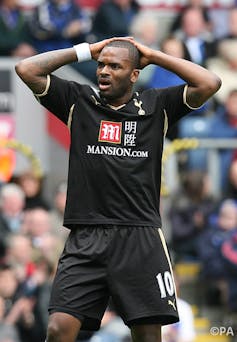![]() Simon Chadwick, Professor of Sport Business Strategy, Coventry University is the author of this article which was originally published in The Conversation, an independent source of news and views from the academic and research community.
Simon Chadwick, Professor of Sport Business Strategy, Coventry University is the author of this article which was originally published in The Conversation, an independent source of news and views from the academic and research community.
Summer’s football transfer rumour season is in full swing; an annual activity as predictable as strawberries and cream at Wimbledon or suntans and sports cars at the Monaco F1 Grand Prix.
World Cup years are always the hottest time for transfer rumours; nevertheless, even when there are no major tournaments taking place, “who goes where and for what” is perpetually on the lips of fans, the screens of newspaper editors, and in the minds of players and agents.
This summer will be no different to any other. Whatever the rumour, however wild it might be, many of us are obsessed with them.
Definition
One definition of a rumour is that it is a piece of information passed from one person to the other, without either of them actually knowing whether the information is true or false. Another, more flippant, the definition is that a rumour is merely a premature fact. Further definitions of rumours have identified them as pieces of unverified information, propositions coloured by shades of doubt and as information created to fill gaps where there is an absence of insight or understanding.
Rumours too are thought to have common characteristics: for instance, they pertain either to current or “local” issues; they are seen as improvised news linked to matters of collective interest, and they help in instilling a sense of belief when reliable information is otherwise unavailable. Indeed, in one study, rumours are highlighted as being “morsels hungrily eaten amid an information famine”.

Summertime is exactly the right time for rumours to propagate and spread, especially when there is no World Cup or continental championship taking place. Sat at an empty table, with ample space into which a rumour can grow, football fans, the media, players and their agents seek the morsels to fill their pub conversations, space on their back pages and assist in the buying and selling of players.
Yet the cycle of rumours has become even more intense than it once was: in the 2002/2003 season FIFA, in coordination with the European Commission, introduced the transfer window to bring stability to the system of buying and selling footballers. Transfers can therefore only take place during two centrally enforced windows, over summer and in January, which means that players may only move from one club to another twice a year. Around these windows, speculation, gossip and rumour are rife.
Sources
To understand football transfer rumours, who starts them, who communicates them and why they circulate requires one to understand the foundations of rumours. Previous research has examined rumours from a number of different perspectives.
Some commentators, believe that rumours should be viewed as two-way economic transactions. That is, there is utility or benefit to be derived by one party communicating a rumour and another receiving it. For instance, in the case of a fan, the summer months are a lean period – no football, no games, no scores, no match reports. Hence, the opportunity to contemplate new player signings has obvious attractions and potential benefits.
At the same time, the football media is able to drive traffic to its websites, newspapers and magazines when there is otherwise not much to report on. Some sites have now taken this even further, designing sophisticated algorithms to figure out exactly what football fans want to read (gathering data on searches for “Arsenal transfer target”, for instance), and then creating rumours to fill this demand.

Martin Rickett/PA
A further economic dimension is that rumours are sometimes used for market-signalling purposes. An agent seeking to find a new club for a player they represent may judiciously brief media contacts, telling them that their player is “looking for a new challenge”, “wants a better salary” or that he “wants to fulfil his potential by playing at a bigger club”. Darren Bent, once of Tottenham Hotspur, even used social media to perpetuate and heighten rumours of his departure (in this instance to Sunderland).
If the media perceives a benefit in communicating the rumour, then it is “broadcast”; the fans respond by sharing it and, so, the market of rumours kicks into action. Some commentators refer to this process as the “infection mechanism” for rumours, the way in which they are spread.
For the agent and player, the ultimate benefit is that clubs become aware of the player’s availability and, whether the player stays at a club or leaves for another, salary levels and payments can often be driven up as a result. Wayne Rooney was offered his current deal with Manchester United after he had spent a week publicly flirting with rivals Manchester City. Whether or not he ever genuinely wanted to move across town, the outcome was extremely lucrative for him and his advisers.
Life without rumours?
There are also socio-cultural and psychological dimensions to rumours. Being a football fan involves talking incessantly during the summer months about players one’s club might sign. It is part of the architecture of fandom, a ritual and a routine that intensifies during the transfer windows. Either explicitly or implicitly, rumours enable fans to engage with football and “their” club, as a means of expressing an affiliation or their loyalty.
Football fans are also routinely affected by what psychologists refer to as BIRG (Bask-In-Reflected-Glory) and CORF (Cut-Off-Reflected-Failure). Hence, when it is rumoured that a club is about to sign the league’s top scorer or the best young player of his generation, fans will often view the rumour as validation of both “their” club and themselves – they BIRG. Conversely, when rumours start that a player who is “past his prime” or is “only coming here for the money”, is heading to your club, fans often actively seek to disassociate or cut themselves off from such signings – they CORF.
It remains a moot point whether we should be concerned about football transfer rumours. To some, they are little more than harmless fun. To organisations such as gambling companies, rumours contribute to their revenues and, therefore, indirectly create jobs.
Yet rumours preoccupy and distract; in each transfer window, some workers spend too much time surfing the web for news of their favourite team’s potential signings, and they then spend further work time discussing whether or not a player will agree on a deal with the club. This can affect output, productivity, efficiency and quality. Other people would counter, claiming that the camaraderie generated by workplace gossip and anticipation delivers tangible benefits for teamwork and an organisation’s culture.
Whatever you think about rumours, when you next discuss the Rooney to Chelsea saga just keep in mind that it is more than simply “newspaper talk”.![]()




